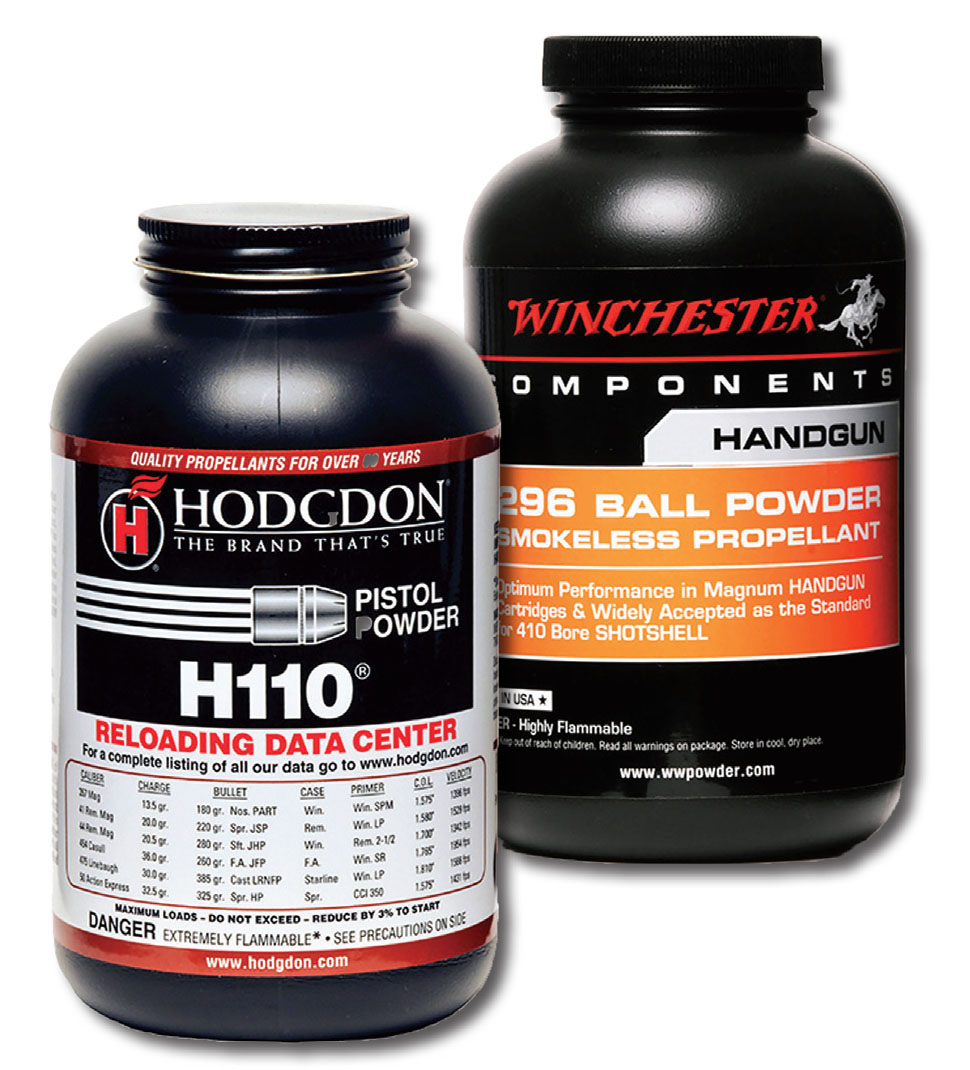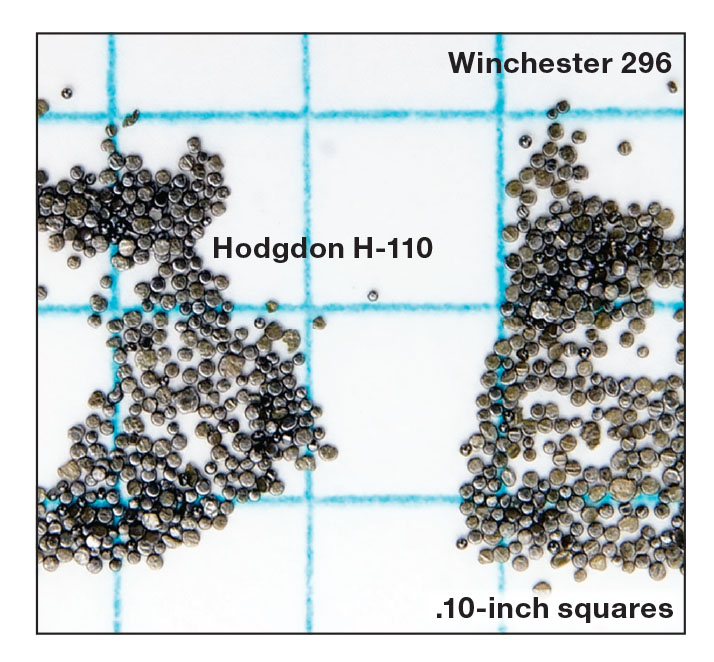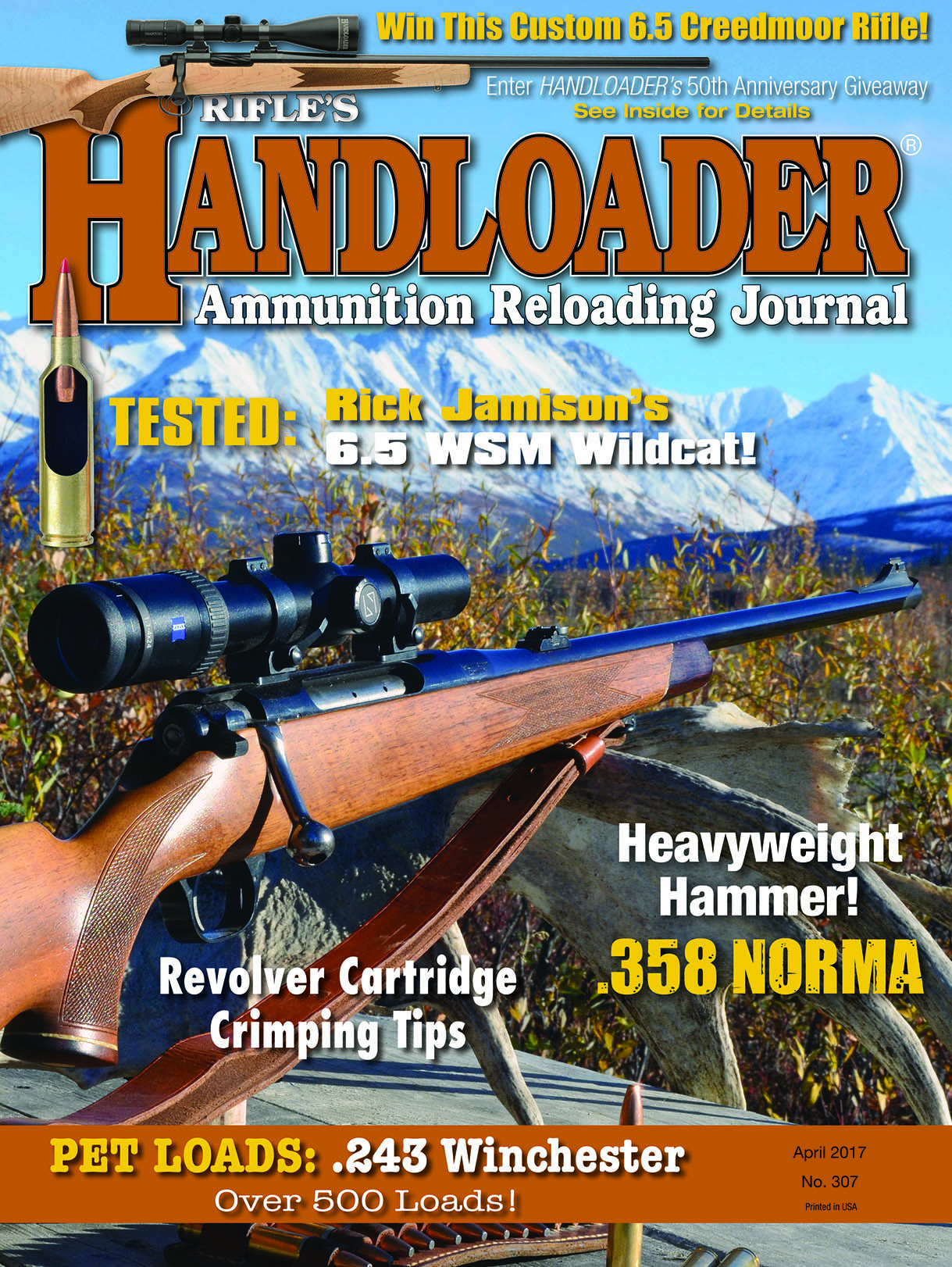Propellant Profile
Hodgdon H-110 - Winchester 296
column By: Randy Bimson |

In the world of hunting rifles and cartridges, there has been little in decades that has stirred up as much interest as the opening of many, mostly Midwest states, to allow hunters the option of using centerfire rifles chambered for straight-walled cartridges for deer hunting in areas where the use of centerfire rifles were previously prohibited and/or allowing these rifles and cartridges to be used in areas previously restricted to muzzleloading firearms or shotguns.
During my years as the director of technical affairs at the Sporting Arms and Ammunition Manufacturers’ Institute (SAAMI), I came to appreciate that whether a new cartridge design lived a long commercial life or was destined to die due to lack of consumer interest was, well, a real crapshoot. The introduction of the .350 Legend by Winchester Ammunition in 2019 was a game changer from the get-go. A cartridge designed specifically to meet the needs of the deer hunter taking advantage of the new regulations allowing certain straight-walled cartridges in rifles. As of this writing, there are at the very least, a dozen makes/models of rifles, including bolt-action, single-shot and self-loading, being chambered for the .350 Legend and more coming online all the time.
A recent survey of a good number of states’ game laws (check your state’s regulations!) shows a multitude of cartridges being approved: .350 Legend, .357 Magnum, .357 Maximum, .375 Winchester, .38-55, .38 Super, .40 S&W, .401 Powermag, 10mm Auto, .41 Remington Magnum, .41 Action Express, .44 S&W Special, .44 Remington Magnum, .44 Automag, .444 Marlin, .445 Super Mag, .45 ACP, .45 Colt, .45 Super Mag, .45 Winchester Magnum, .45 Silhouette, .450 Bushmaster, .451 Detonics, .454 Casull, .45-70 Govt., .45-90, .45-110, .460 Rowland, .460 S&W Mag, .475 Widley Magnum, .475 Linebaugh, .480 Ruger, .50 Action Express, .50 Linebaugh, .50 Beowulf, .500 S&W Mag, .50-70, .50-90, .50-100 and .50-110.
With the exception of 11 cartridges originally designed as rifle cartridges, the rest evolved as handgun cartridges with a case length of 1.800 inches or less. The length of 1.800 inches is currently the longest case for a cartridge designed specifically for handguns and affirmed by SAAMI. It also happens to be one of the criteria used by many of the states to define straight-wall pistol cartridges allowable for use in rifles for deer hunting.
This brings me to this edition’s topic, Hodgdon H-110 and its twin, Winchester 296, (referred to here as H-110/W-296) are propellants that just happen to be very capable performers in many of the deer-hunting authorized straight-wall cartridges, like the .350 Legend, listed above. H-110/W-296 is by no means a new kid on the block when it comes to propellants. It first came onto the market circa 1962 when Hodgdon offered a military-surplus powder, originally formulated by then Olin Corporation/Winchester Ammunition for the .30 M1 Carbine cartridge, to the handloading market as a canister powder branded H-110. When the surplus supplies of H-110 were exhausted, Hodgdon turned to the original source for a continuing supply. In 1973 Olin/Winchester replaced most of its then existing lineup of Ball powders with a completely new line of Ball powders (Ball being a registered trademark). One of the new powders introduced was Winchester 296, for all intents and purposes, the twin of the H-110 powder being marketed at the time by Hodgdon.
While originally intended for loading the .30 Carbine cartridge, it has proved to be an exceptional powder for loading the .410 shotshells, but with that exception, most of the H-110/W-296 used by handloaders is burned in the straight-wall, high-intensity cartridges in the list above. From the .357 Magnum to the .500 S&W Magnum, usually when loaded with the heavier range of bullet weights, and the more recent .350 Legend, H-110/W-296 is considered by many handloaders (myself included) to be the powder of choice for such applications.

H-110/W-296 is by chemical makeup a double-base propellant with nitrocellulose being the principal energetic base and 10 percent nitroglycerine content being the secondary energetic base. H-110/W-296 is formed of extremely fine-grained flattened spheres, ranging in diameter from near specks to a diameter of a nominal .037 inch. H-110/W-296 is a “sparkly” silver-gray in color. A very dense powder, where water is assigned a value of 1.000 g/cc (g donating the weight in grams), H-110/W-296’s bulk density is .950 g/cc. The very fine granulation of H-110/W-296 make it prime candidate for use with a good quality powder measure where it will meter extraordinarily uniform charges. In the most recently published Hodgdon Relative Burn Rate chart H-110/W-296 sits right in between Hodgdon Lil’Gun, which is faster burning, and the slower burning IMR 4227. H-110/W-296 is so chemically stable and so highly resistant to moisture absorption that it has, as best we know, virtually an unlimited storage life.
It has been well-known in the handloading community for many years that Hodgdon purchased spherical powders from Winchester and in the early 2000s, Hodgdon acknowledged that their HS-6 and HS-7 shotshell powers were the same as Winchester branded 540 and 571 and any noted difference in performance was attributed to normal lot-to-lot variations. Looking at any of the recent Hodgdon reloading data manuals and clearly it is the case with several other Winchester and Hodgdon-branded powders that are listed having identical ballistics with identical component combinations: W-231 and HP-38, W-760 and H-414, and of course, W-296 and H-110.
Winchester Ball powders have for many years been produced in a facility located in Florida known as St. Marks powder plant, now owned and operated by General Dynamics. Hodgdon has a licensing agreement with Winchester Ammunition to develop and market Winchester Ball powders alongside Hodgdon’s in-house brands. It is interesting to note that while under Winchester Ammunition, the Winchester loading data booklets listed a number of caveats relative to handloading with 296: use data exactly as shown in the Winchester loading data, never reduce charges of 296 powder; use a “very heavy crimp;” use a (Winchester) magnum pistol primer. It is my contention that the caveats Winchester attached to 296 were during the early days of 1970s and 1980s when loading high-performance magnum loads was becoming more of an everyday handloading practice and it was Winchester’s effort to educate the handloader on the need for: high bullet pull (very heavy crimp); choose a propellant that uses a high percentage of the cartridge case’s powder capacity (high-load density); use a magnum pistol primer to ensure consistent ignition, particularly in cold weather. Looking at any more recent Hodgdon and other reloading data and you will now find both “starting” and “maximum” loads, and load data that does not call out the use of magnum primers. Use common sense and test your loads to ensure proper function in your rifle under field conditions.
While H-110/W-296 has limited applications in traditional rifle category cartridges beyond the .30 Carbine, .22 Hornet, .218 Bee, and a few dual-purpose cartridges like the .221 Fireball, .256 Winchester Magnum, .25-20, it is an excellent .410 shotshell powder and has few peers when it comes to loading so many of the “straight-wall” designated deer-hunting cartridges.
Personally, H-110/W-296 is my go-to powder for a great number of the cartridges in the “straight-wall deer-hunting cartridge” list above, particularly my long-standing favorite, the .44 Remington Magnum. My hunting handgun, a S&W Performance Center 629 Hunter revolver fitted with a Leupold M8 2x pistol scope, shot from a Ransom International Multi-Caliber Steady Rest, six rounds loaded with 24 grains of H-110 behind the Hornady 240-grain XTP bullet will regularly shoot sub-2-inch groups at 100 yards when I do my part. Who can argue with performance like that?
H-110 is available in 1- and 8-pound containers while Winchester 296 is packaged in 1-, 4- and 8-pound containers.
.jpg)


